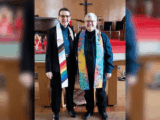Christian Schwarz is a German researcher and author who looked at churches around the world. He talks to Connie denBok about the eight universal characteristics of what he calls “Natural Church Development.”
CONNIE DENBOK: What are the eight characteristics of Natural Church Development (NCD)?
You may unsubscribe from any of our newsletters at any time.
CHRISTIAN SCHWARZ: The eight characteristics are empowering leadership, gift-based ministry, connecting with God, effective structures, inspiring worship, needs-based evangelism, holistic small groups and loving relationships.
CD: What does your research say to the Canadian church?
CS: Most studies focus on a country or denomination. We are more interested in universal principles of growth, which are as true in the Vietnamese Roman Catholic Church as a Baptist Church in Denmark. I say this even from a European background where many mainline churches are in decline.
CD: What trends to you see in mainline churches around the world?
CS: Many mainline churches struggle with a mental mindset that accepts loss as a given, an unchangeable force of nature — like an earthquake. This is simply untrue. It is theologically untrue and empirically untrue. All mainline churches have individual congregations that have managed to reverse the trend. It takes a while, but they have changed the quality of their church’s life and sometimes even their quantity or growth.
In fact, what we see from an NCD perspective worldwide is that the most sustainable growth has happened in mainline churches. In Canada, the initial interest 10 years ago was from experimental emerging churches, but now we see mostly representatives of the historical churches who have begun to track quality. The results are very encouraging.
Also, many mainline denominations are very liberal — which in itself is neutral because there are enormous strengths in this approach — but some of them are significantly underdeveloped in other areas from which they could benefit.
CD: What areas are you referring to specifically?
CS: All churches have natural extremes.
A church may take strong stands for social justice but be very weak at relating to Christ and issues of salvation. Or it may have a deep spiritual emphasis that does not connect to their neighbour. So they are strong, but not balanced. And it would not violate their theological roots and traditions to develop a more balanced profile.
In the mainline churches, the world may be emphasized at the expense of the Word and the Spirit. For instance, if you could disconnect the God of creation from Jesus and the Bible, the natural result is synchronism — a spirituality where all faiths are almost the same because there are no distinctives. This is a superficial way to deal with differences and takes away spiritual passion because all that remains is the lowest common denominator.
CD: What are mainline denominations doing right?
CS: The mainline churches often have a strong connection to God as creator of the world, so social justice and environmental issues come most naturally. They are also good at using the senses and the rational mind as ways of relating to God.
CD: Looking through the eight characteristics of Natural Church Development, I didn’t see a commitment to social justice on the list. Does it fit in?
CS: Social justice is important to me, but I had to remain neutral in order to find universal growth factors. There are many things in the Bible that are not universal growth standards but clearly must be done — even if they result in losing members. We don’t want to fall into an opportunistic market-driven philosophy just to gain people.
I recently had a discussion with a minister in South Africa who, in the days of anti-apartheid activity, lost many people because [activism] was the right thing to do.
Social justice does factor into the eight characteristics. It is part of the quality of a church’s loving relationships and is deeply integrated with their needs-based evangelism.
CD: I’m a minister of a congregation. What is the first thing I can do to correct the imbalance and start growing my church?
CS: You just evaluate the quality of your church in eight important areas, and you invest your energy in the most critical factor. For instance, one of the eight may indicate a need to grow in love.
CD: What role does the denomination’s head office play in a local church’s outlook and health?
CS: My mentality is very much grass-roots. Everything can be done without the backup of a head office. The number one reason we have denomination offices is to support local churches in getting healthy and finally seeing numerical growth. This should be the job description of any president, bishop, superintendent, whatever they are called. Churches report their finances every year but there are even more important things, like how many people are experiencing God in worship? How many people find their church activities match their spiritual gifts? Is our church creative in its approach to evangelism? These can also be measured.
CD: Your research identifies nine spiritual styles, ways people connect to God. Is church decline linked to conflicting styles?
CS: Sometimes, yes. If you analyze conflicts within churches, they may appear as theological differences but are in fact differences of style. Often when individuals do not feel accepted in a church, their specific style is not recognized there.
In my experience, tremendous conflict can be used creatively for health. I have hundreds of examples where opposite styles can benefit each other. A particular diocese decided to look for a youth minister with a style in which they were markedly deficient. Some said it would bring conflict — but they already had conflicts. Everyone understood that they had to compensate for a weakness in order to reach different people. This person was hired and the diocese saw desired change because that particular approach was appreciated by the youth.
Sometimes church splits and firings are simply because of an inadequate paradigm. So rather than avoiding conflicts, it is possible to utilize the energy. When people fight for truth, the emotional and spiritual energy can be turned to co-operation rather than attack. With the Trinitarian Compass, there’s an understanding that people who would normally be in conflict can learn from each other.
CD: The Trinitarian Compass? What is that?
CS: With Natural Church Development, the Trinity brings us to a centre where World, Word and Spirit must be together. Differences are not a threat because we have a paradigm to create understanding and balance. We call this the Trinitarian Compass. The arrow always points to the centre.
CD: How can you foster all nine spiritual styles in one church?
CS: First we must know that every church already has all nine spiritual styles. There are those who experience God primarily through sacraments, senses, rationally, doctrinally, in Scripture, sharing, aesthetics, enthusiasm or mystically. But it is not enough to know. We must develop balance in ourselves and appreciate the styles that are not our own— and be able to integrate elements that will make us more authentic.
***
This story first appeared in The United Church Observer’s February 2010 issue with the title “‘Many mainline churches accept loss as a given. This is simply untrue.’”













